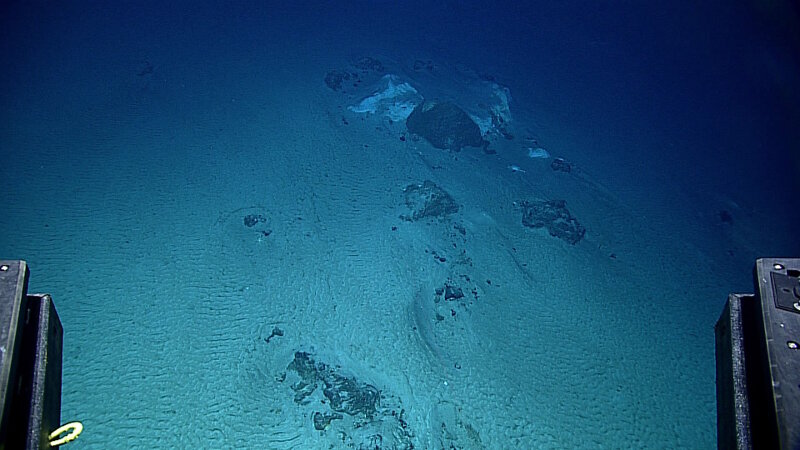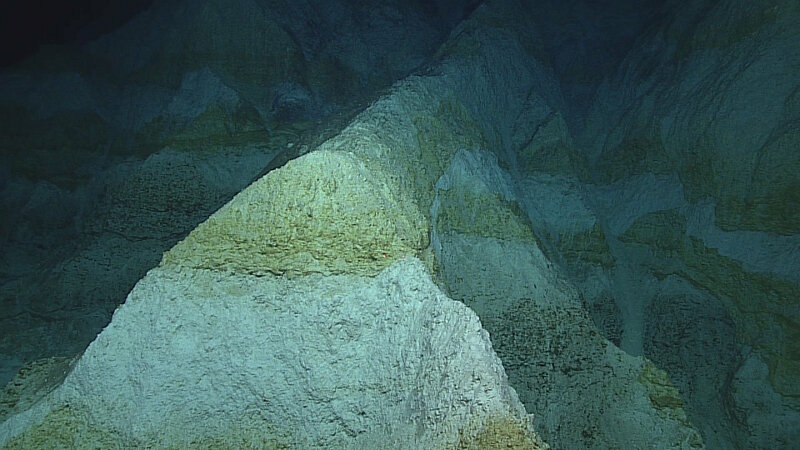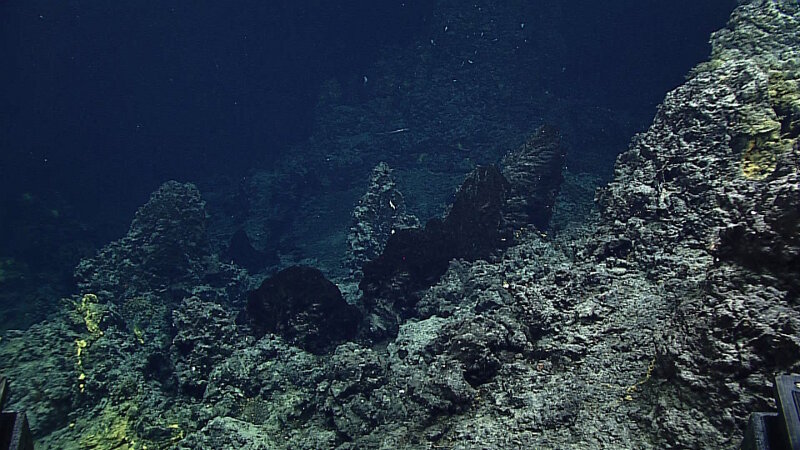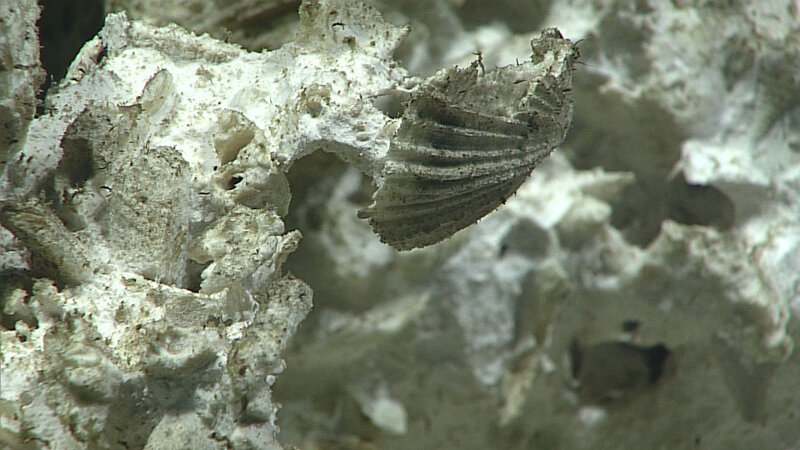
By Deborah Glickson - Harbor Branch Oceanographic Institute at Florida Atlantic University
July 5, 2016
When I was asked to be the geology science lead on Leg 1 of the Deepwater Exploration of the Marianas expedition, I was thrilled! Who wouldn’t be? The Mariana region is on the bucket list for any oceanographer, deep-sea scientist, or geologist! What made this expedition so interesting was the variety of geologic environments we were going to explore, from the familiar to the very mysterious.

Volcaniclastics on Dive 3 at Maug Volcano. Image courtesy of NOAA Office of Ocean Exploration and Research, 2016 Deepwater Exploration of the Marianas. Download larger version (jpg, 1.5 MB).
These included hydrothermal vents, mud volcanoes, seamounts, and even the Mariana Trench itself. Because the Mariana region is so volcanically active, we expected to see lots of igneous rocks, which form as magma or lava cools and solidifies. And perhaps unsurprisingly, we’ve seen quite a variety of igneous rocks and morphologies (the forms that these rocks take).
Our first dives of Leg 3, at Farallon de Medinilla and Maug (Dive 1 and Dive 3), began with a bang – literally! The volcaniclastics and consolidated ash flows we saw formed during episodes of explosive volcanic activity. We even saw graded bedding, which was really neat! Other fascinating igneous rock moments included sightings of columnar jointing and other complex fracture patterns that formed as lava cools.

Peridotite boulders in rippled sediment on Dive 4 at Hadal Ridge. Image courtesy of NOAA Office of Ocean Exploration and Research, 2016 Deepwater Exploration of the Marianas. Download larger version (jpg, 787 KB).
Great as this geology was, it wasn’t nearly as cool as our 6,000-meter dive to Hadal Ridge (Dive 4), deep within the trench itself. First, we saw what we interpreted as peridotites, which are formed deep within the Earth’s mantle.

Carbonate rocks forming an Alps-like landscape on Dive 4 at Hadal Ridge. Image courtesy of NOAA Office of Ocean Exploration and Research, 2016 Deepwater Exploration of the Marianas. Download larger version (jpg, 854 KB).
Who knows what processes they’ve undergone before they were exposed along the inner wall of the trench? It boggles the mind! But then…it got even better! All of a sudden, we found ourselves in an area that looked like the underwater Alps; mountains with layer after layer of a whitish rock that were likely composed of calcium carbonate.

Small hydrothermal vent chimneys on Dive 7 at Chamorro Seamount. Image courtesy of NOAA Office of Ocean Exploration and Research, 2016 Deepwater Exploration of the Marianas. Download larger version (jpg, 984 KB).
We thought that this may have been created by serpentinization processes similar to those that formed the Lost City Hydrothermal Field, which was the site of a NOAA telepresence expedition in 2005.

Crusts of elemental sulfur on Dive 9 at Daikoku Seamount. Image courtesy of NOAA Office of Ocean Exploration and Research, 2016 Deepwater Exploration of the Marianas. Download larger version (jpg, 1.0 MB).
Speaking of hydrothermal fields, another geological surprise was found at Chamorro Seamount (Dive 7) at less than 1,000 meters – small hydrothermal vent chimneys that supported a variety of vent fauna.

Ferromanganese crusts draping rocks (and even old sponge stalks) on Dive 17 at Fryer Guyot. Image courtesy of NOAA Office of Ocean Exploration and Research, 2016 Deepwater Exploration of the Marianas. Download larger version (jpg, 1.0 MB).
While perhaps not quite as spectacular as the 30-meter-tall chimney we saw on Leg 1, there is never a boring hydrothermal vent dive! And at Daikoku (Dive 9), we encountered crusts of elemental sulfur that originated as pools of molten sulfur! Super weird!

Cretaceous-age fossils on Dive 16 at Subducting Guyot 1. Image courtesy of NOAA Office of Ocean Exploration and Research, 2016 Deepwater Exploration of the Marianas. Download larger version (jpg, 804 KB).
We’ve also had a chance to see some very interesting sedimentary geology. A number of our dives have featured ferromanganese crusts, which actually precipitate out of seawater in areas of the ocean where oxygen is low. The crusts have the unfortunate side effect of blanketing the rocks they form on top of, making it really hard to determine what lies beneath.
And most recently, we climbed along the wall of a seamount (Dive 16), exploring Cretaceous-age sedimentary outcrops. Even the non-geologists were excited to see bivalve and other fossils, although they might have enjoyed encountering a few more live organisms in addition to the geology.

Remotely operated vehicle Deep Discoverer exploring the seamount wall on Dive 16 at Subducting Guyot 1. Image courtesy of NOAA Office of Ocean Exploration and Research, 2016 Deepwater Exploration of the Marianas. Download larger version (jpg, 629 KB).
Overall, I keep being amazed by the diverse geology we’ve been able to explore during Leg 3 of the exploration of the Mariana region and can’t wait to see what the next few dives hold!